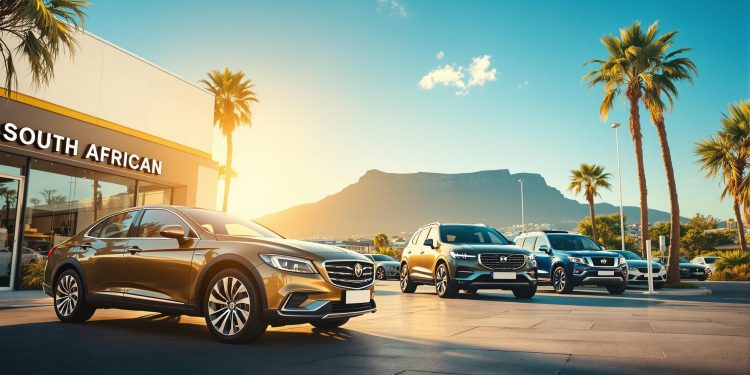Exchange rates directly influence car prices in South Africa. A weaker Rand makes imported cars more expensive and raises costs for locally made vehicles due to imported components. For instance, a $30,000 imported car costs R540,000 when the Rand falls from 15 to 18 ZAR/USD.
Key insights:
- Imported cars: Prices rise immediately with Rand depreciation (10-12% increase expected in 2025).
- Locally made cars: Prices increase moderately (6-8%) due to imported parts.
- Used cars: Indirectly affected, with prices climbing 5-7%.
Quick Comparison Table
| Vehicle Type | Exchange Rate Impact | Price Stability |
|---|---|---|
| Imported Cars | High (Immediate) | Low |
| Locally Manufactured | Moderate | Higher |
| Used Cars | Indirect | Varies |
Buying tips: Monitor Rand trends, buy during year-end sales, and consider locally made models to avoid steep price hikes.
Understanding Exchange Rates and the South African Rand
What Are Exchange Rates?
Exchange rates show how much one currency is worth compared to another. For South African car buyers, this means understanding how many Rands (ZAR) are needed to buy a foreign currency like the US Dollar (USD) or Euro (EUR). Changes in exchange rates don’t affect prices immediately. Factors like market competition, stock levels, and pricing strategies can delay the impact. These elements influence car prices in three main ways, which we’ll break down later.
Factors Influencing the Rand’s Value
Several factors shape the strength of the Rand, and they also affect the cost of imported vehicles:
| Factor | Influence on Rand | Effect on Consumers |
|---|---|---|
| GDP Growth | Boosts Rand strength | Reduces import costs |
| Rate Increases | Attracts foreign investment | Helps stabilize prices |
| Political Instability | Weakens the Rand | Creates pricing uncertainty |
| Commodity Prices | Higher exports strengthen Rand | Supports market stability |
| Trade Balance | Positive balance strengthens currency | Adds pricing predictability |
Decisions by the South African Reserve Bank are especially important. For example, when the repo rate was adjusted to 7.75% in late 2024, it directly impacted the Rand’s value and the cost of imported goods, including vehicles.
Recent Trends in Rand Exchange Rates
The Rand has weakened noticeably over the past few years, dropping from 14.79 ZAR/USD in 2021 to 18.54 ZAR/USD in 2023. This steady decline has increased costs, adding pressure on consumers. In the next section, we’ll dive into how this directly affects car prices.
Why the South African Rand is Losing Strength: Key Factors Explained
How Exchange Rates Impact Car Costs in South Africa
Exchange rates play a key role in determining the cost of both imported and locally produced cars in South Africa.
Impact on Imported Cars
When the South African Rand loses value, imported car prices increase. For instance, a $30,000 car would go from R450,000 to R540,000 if the Rand slides from 15 to 18 ZAR/USD [3].
This doesn’t just affect the car’s sticker price – it also raises costs for parts and maintenance. Here’s how a 10% depreciation in the Rand impacts various categories:
| Cost Category | Effect of 10% Rand Depreciation |
|---|---|
| New Vehicle Price | 8-10% increase |
| Imported Parts | 9-11% increase |
| Service Costs | 5-8% increase |
| Consumables | 7-9% increase |
Effect on Locally Made Cars
Locally assembled cars aren’t completely shielded from currency shifts. Around 70-80% of the components used in South African-assembled vehicles are imported [2]. This dependency means that even local car prices are influenced by exchange rate changes.
To counteract this, some manufacturers are increasing local production of parts. For example, Volkswagen raised the local content in their Polo model from 60% to 70% after a sharp Rand depreciation [2].
Timeframe for Price Changes
Exchange rate changes don’t hit car prices overnight. It generally takes 3-6 months for retail prices to fully reflect significant currency shifts [4].
Here’s why:
- Manufacturers often have stock bought at earlier exchange rates.
- Currency hedging helps shield against sudden changes.
- Dealers may temporarily absorb some costs to maintain sales.
In Q4 2023, new vehicle prices rose by 6.3%, while used car prices increased by 6.4%, both outpacing inflation by about three percentage points [5]. The average financed amount for vehicle loans also climbed from R386,000 in Q4 2022 to R396,000 in Q4 2023 [5]. This lag explains why price changes at dealerships aren’t always immediate.
sbb-itb-09752ea
Trends in South African Car Prices
Car prices in South Africa have been heavily influenced by changes in the exchange rate. Data from TransUnion Africa shows that in Q4 2023, new vehicle prices rose by 6.3%, while used car prices climbed by 6.4%, both outpacing general inflation [4].
New vs Used Car Price Trends
Between 2020 and 2024, new car prices increased by 6-8% annually, closely tied to the Rand’s depreciation from 14 to over 18 ZAR/USD. Meanwhile, used cars showed steadier annual increases of 3-5%. However, financing trends indicate upward pressure across both new and used segments.
Imported vs Locally Made Cars
Exchange rate shifts have created a noticeable pricing gap between locally produced and imported vehicles. Here’s how categories compare:
| Vehicle Category | Annual Price Increase (2023-2024) | Primary Exchange Rate Impact |
|---|---|---|
| Locally Manufactured | 6.4% | Component costs, delayed effect |
| Fully Imported | 11.6% | Immediate price adjustment |
| Used Vehicles (1-3 years) | 3-5% | Indirect market pressure |
Examples of Exchange Rate Impact on Car Models
Exchange rate changes have directly impacted the pricing of popular car models:
-
Volkswagen Polo (Locally Manufactured)
The Polo, assembled locally but with some imported parts, saw its price rise by 6.4%. It went from R311,000 in January 2023 to R331,000 in January 2024 [2]. -
Toyota Corolla (Imported)
Fully imported models like the Toyota Corolla experienced sharper price hikes. Its price jumped 11.6%, from R423,000 to R472,000, reflecting the Rand’s depreciation against the Yen [4].
Tips for Buying Cars During Exchange Rate Fluctuations
Best Time to Buy a Car
Keeping an eye on economic trends can help you spot the right time to buy. When the Rand is strong against major currencies like the US Dollar, buyers often find better deals.
Timing your purchase around end-of-year sales (December/January) or tax season (February to July) can also save you money. Prices during these periods often drop by 3-5%, as dealerships aim to hit their sales targets. Combine this timing with currency monitoring tools for the best results.
Choosing Imported vs Locally Made Cars
Whether you choose an imported or locally manufactured car can greatly affect how exchange rate changes impact you. Here’s a quick comparison:
| Vehicle Type | Exchange Rate Impact | Price Stability |
|---|---|---|
| Locally Made | Moderate | Higher |
| Imported | Immediate | Lower |
| Demo Models | Limited | Highest |
Once you’ve decided on the type of vehicle, the next step is to negotiate wisely.
Negotiating Car Prices During Currency Volatility
Negotiating effectively during times of currency volatility requires preparation and strategy.
Here’s how you can improve your chances:
- Do your homework: Research market prices thoroughly to understand what’s reasonable.
- Time your purchase: Aim for the end of a month or quarter, when dealerships are more likely to offer discounts to meet sales targets. Seasonal promotions can also work in your favor.
- Lock in financing terms: Go for fixed-rate financing to protect yourself from potential rate hikes.
For larger purchases, ask for a price guarantee clause to shield yourself from unexpected increases caused by exchange rate changes.
Future Outlook for Exchange Rates and Car Prices
Rand Projections for 2025-2026
Economic forecasts suggest the South African Rand will likely weaken further against major currencies. By January 2026, analysts expect the Rand to trade at around 20.29 ZAR per USD, reflecting an 8.7% drop from current levels [1]. Factors influencing this trend include the country’s GDP growth, commodity price movements, and levels of foreign investment.
Expected Changes in Car Pricing
If these exchange rate projections hold, car prices in South Africa are likely to climb. The predicted 8-10% depreciation of the Rand will have a direct effect on vehicle costs, especially for imported models.
| Vehicle Category | Price Impact Estimate |
|---|---|
| Imported Cars | 10-12% increase |
| Locally Assembled Cars | 6-8% increase |
| Used Vehicles | 5-7% increase (varies) |
Policy Shifts and Their Influence
The Automotive Production and Development Programme, combined with the African Continental Free Trade Area (AfCFTA), could potentially ease price pressures by improving trade within the region. Changes to South Africa’s automotive production incentives may also influence manufacturing costs locally.
The South African Reserve Bank’s monetary policy, particularly decisions tied to interest rates, will remain key in managing exchange rate fluctuations. Higher interest rates often support a stronger currency, which could help control vehicle price increases. Additionally, the bank’s focus on inflation will shape overall pricing trends in the automotive market.
Conclusion: Key Points for South African Car Buyers
Understanding Exchange Rate Effects
The Rand is expected to drop to 20.29 ZAR/USD by 2026, which means imported cars could see price hikes of 8-10% annually, compared to 3-5% for locally made vehicles [1]. This makes local models a smarter choice for those looking to avoid steep price increases. If you’re considering an imported car, it’s worth factoring in exchange rate trends to decide the best time to buy. Financing options may also become more important as these price pressures grow.
Where to Stay Informed
For real-time updates on exchange rates and their effect on car prices, check out ImotoNews South Africa (https://imotonews.co.za) for the latest automotive trends. For used car listings and additional market insights, visit AUTO24.co.za.
Here’s a quick breakdown of how market conditions could influence your buying decision:
| Market Condition | Impact on Buying Decision |
|---|---|
| Strong Rand | Imported cars become cheaper |
| Weak Rand | Imported car prices increase |
| Price Increase Announced | Urgent buying may be necessary |
| Year-End | Possible dealership incentives |
Keep an eye on SARB reports for Rand performance and consider visiting dealerships at the end of a quarter to find better deals.
Related Blog Posts
- Factors That Influence Used Car Prices in South Africa
- Top 5 Cars for South African Roads
- CPO Cars vs Regular Used Cars: Resale Value
- Luxury Car Market in South Africa: 2025 Price Forecast





